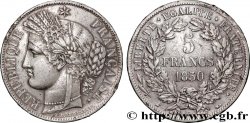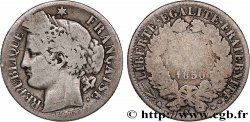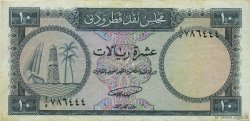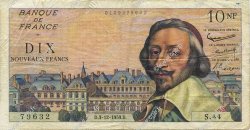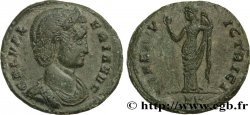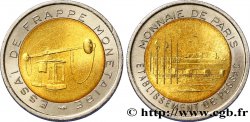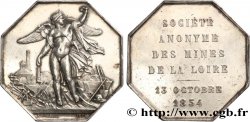fmd_309959 - Concours de 5 francs, essai en étain par Alard 1848 Paris VG.3059 var.
non disponibile.
Articolo venduto sul nostro negozio (2014)
Prezzo : 250.00 €
Articolo venduto sul nostro negozio (2014)
Prezzo : 250.00 €
Tipo : Concours de 5 francs, essai en étain par Alard
Data: 1848
Nome della officina / città: Paris
Quantità coniata : ---
Metallo : stagno
Diametro : 37 mm
Asse di coniazione : 6 h.
Peso : 17,30 g.
Orlo : lisse
Grado di rarità : R1
N° nelle opere di riferimento :
Pedigree :
Cet exemplaire provient de MODERNES IX n° 1007
Diritto
Titolatura diritto : REPUBLIQUE - FRANÇAISE.
Descrittivo diritto : Buste casqué de la République à gauche surmontée d'un coq ; signature cursive F. Alard au-dessous.
Rovescio
Titolatura rovescio : LIBERTÉ ÉGALITÉ FRATERNITÉ.
Descrittivo rovescio : 5/ FRANCS/ 1848 en trois lignes dans une couronne formée d’une branche de chêne et d’une branche d’olivier.
Commento
Le 24 février 1848, après l'abdication de Louis-Philippe en faveur de son petit fils, la République est proclamée avec une rapidité étonnante. Les fabrications monétaires reprennent les anciens types de Dupré, à l'Hercule pour les 5 francs dont les fabrications commencent le 19 mars et au Génie pour les 20 francs dont les fabrications commencent le 12 mai. Le 3 mai, le nouveau gouvernement, élu en avril, décrète la création de nouveaux types pour les monnaies. Le même jour un concours est organisé pour la gravure des coins des nouvelles espèces. Trente et un artistes participent au concours : Alard, Barre, Boivin, Borrel, Bouchon, Bouvet, Bovy, Catel, Caunois, Dantzell, Desbœufs, Dieudonné, Domard, Farochon, Fauque, Gayrard, Leclerc, Magniadas, Malbet, Marrel, Merley, Montagny, Moullé, Oudiné, Pillard, Pingret, Reynaud (termina après la date de clôture), Rogat, Tournier, Vauthier-Galle et Vivier. Tandis que certains ne se présentent que pour un type (Bouchon ou Caunois pour l'argent par exemple), d'autres artistes participent pour les trois métaux (Boivin, Dieudonné ou Oudiné par exemple), et d'autres présentent des épreuves multiples (deux dans chaque métal pour Montagny, quatre en bronze pour Rogat, sept en tout pour Gayrard). Les prix sont obtenus par Merley pour l'or, Oudiné pour l'argent et Domard pour le cuivre. Barre et Oudiné obtiennent un accessit pour l'or, Barre et Domard obtiennent un accessit pour l'argent, Barre et Oudiné obtiennent un accessit pour le cuivre.
On February 24, 1848, after the abdication of Louis-Philippe in favor of his grandson, the Republic was proclaimed with astonishing speed.. The coin productions resume the old Dupré types, with the Hercules for the 5 francs whose production begins on March 19 and the Génie for the 20 francs whose production begins on May 12.. On May 3, the new government, elected in April, decreed the creation of new types of coins.. On the same day a competition is organized for the engraving of the dies of the new species. Thirty-one artists participated in the competition: Alard, Barre, Boivin, Borrel, Bouchon, Bouvet, Bovy, Catel, Caunois, Dantzell, Desboeufs, Dieudonné, Domard, Farochon, Fauque, Gayrard, Leclerc, Magniadas, Malbet, Marrel, Merley, Montagny, Moullé, Oudiné, Pillard, Pingret, Reynaud (ended after the closing date), Rogat, Tournier, Vauthier-Galle and Vivier. While some only present themselves for one type (Bouchon or Caunois for silver for example), other artists participate for all three metals (Boivin, Dieudonné or Oudiné for example), and others present multiple proofs (two in each metal for Montagny, four in bronze for Rogat, seven in all for Gayrard). Prices are obtained by Merley for gold, Oudiné for silver and Domard for copper. Barre and Oudiné get a gold medal, Barre and Domard get a silver medal, Barre and Oudiné get a copper medal
On February 24, 1848, after the abdication of Louis-Philippe in favor of his grandson, the Republic was proclaimed with astonishing speed.. The coin productions resume the old Dupré types, with the Hercules for the 5 francs whose production begins on March 19 and the Génie for the 20 francs whose production begins on May 12.. On May 3, the new government, elected in April, decreed the creation of new types of coins.. On the same day a competition is organized for the engraving of the dies of the new species. Thirty-one artists participated in the competition: Alard, Barre, Boivin, Borrel, Bouchon, Bouvet, Bovy, Catel, Caunois, Dantzell, Desboeufs, Dieudonné, Domard, Farochon, Fauque, Gayrard, Leclerc, Magniadas, Malbet, Marrel, Merley, Montagny, Moullé, Oudiné, Pillard, Pingret, Reynaud (ended after the closing date), Rogat, Tournier, Vauthier-Galle and Vivier. While some only present themselves for one type (Bouchon or Caunois for silver for example), other artists participate for all three metals (Boivin, Dieudonné or Oudiné for example), and others present multiple proofs (two in each metal for Montagny, four in bronze for Rogat, seven in all for Gayrard). Prices are obtained by Merley for gold, Oudiné for silver and Domard for copper. Barre and Oudiné get a gold medal, Barre and Domard get a silver medal, Barre and Oudiné get a copper medal








 Segnalare un errore
Segnalare un errore Stampate la pagina
Stampate la pagina Condividi mia selezione
Condividi mia selezione Fai una domanda
Fai una domanda Consegnare / vendere
Consegnare / vendere
 Descrittivo
Descrittivo